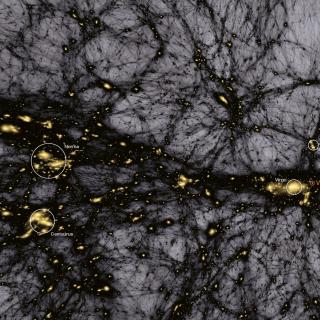Bibcode
Kitaura, F. -S.; Sinigaglia, F.; Balaguera-Antolínez, A.; Favole, G.
Bibliographical reference
Astronomy and Astrophysics
Advertised on:
3
2024
Journal
Citations
7
Refereed citations
7
Description
Context. Analysing the large-scale structure (LSS) in the Universe with galaxy surveys demands accurate structure formation models. Such models should ideally be fast and have a clear theoretical framework in order to rapidly scan a variety of cosmological parameter spaces without requiring large training data sets.
Aims: This study aims to extend Lagrangian perturbation theory (LPT), including viscosity and vorticity, to reproduce the cosmic evolution from dark matter N-body calculations at the field level.
Methods: We extend LPT to a Eulerian framework, which we dub eALPT. An ultraviolet regularisation through the spherical collapse model provided by Augmented LPT turns out to be crucial at low redshifts. This iterative method enables modelling of the stress tensor and introduces vorticity. The eALPT model has two free parameters apart from the choice of cosmology, redshift snapshots, cosmic volume, and the number of particles.
Results: We find that compared to N-body solvers, the cross-correlation of the dark matter distribution increases at k = 1 h Mpc−1 and z = 0 from ∼55% with the Zel'dovich approximation (∼70% with ALPT), to ∼95% with the three-timestep eALPT, and the power spectra show percentage accuracy up to k ≃ 0.3 h Mpc−1.
Aims: This study aims to extend Lagrangian perturbation theory (LPT), including viscosity and vorticity, to reproduce the cosmic evolution from dark matter N-body calculations at the field level.
Methods: We extend LPT to a Eulerian framework, which we dub eALPT. An ultraviolet regularisation through the spherical collapse model provided by Augmented LPT turns out to be crucial at low redshifts. This iterative method enables modelling of the stress tensor and introduces vorticity. The eALPT model has two free parameters apart from the choice of cosmology, redshift snapshots, cosmic volume, and the number of particles.
Results: We find that compared to N-body solvers, the cross-correlation of the dark matter distribution increases at k = 1 h Mpc−1 and z = 0 from ∼55% with the Zel'dovich approximation (∼70% with ALPT), to ∼95% with the three-timestep eALPT, and the power spectra show percentage accuracy up to k ≃ 0.3 h Mpc−1.
Related projects

Cosmology with Large Scale Structure Probes
The Cosmic Microwave Background (CMB) contains the statistical information about the early seeds of the structure formation in our Universe. Its natural counterpart in the local universe is the distribution of galaxies that arises as a result of gravitational growth of those primordial and small density fluctuations. The characterization of the
FRANCISCO SHU
KITAURA JOYANES